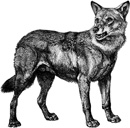The Wildlife Web II - Teacher's Guide |
Episode Overview In the opening segment, Patrice explains how herbivores and carnivores depend on each other for survival. Next, Patrice joins Dave and learns about an insect eating predator, the brown bat. In the third segment, we take an up-close look at the gray wolf. Finally, Sarah and Cody visit a bat cave with Peter Benson from the Nature Conservancy. In the opening segment, Patrice explains how herbivores and carnivores depend on each other for survival. Next, Patrice joins Dave and learns about an insect eating predator, the brown bat. In the third segment, we take an up-close look at the gray wolf. Finally, Sarah and Cody visit a bat cave with Peter Benson from the Nature Conservancy.
Program ObjectivesStudents will:1. Investigate and understand that organisms depend on other organisms and nonliving components of the environment for survival. 2. Describe common adaptations exhibited by carnivores. 3. Describe the role carnivores, omnivores and herbivores play in the food web. 4. Recognize the distinct characteristics of the brown bat and the gray wolf. Vocabulary
Previewing ActivityPass out three post-it notes to each student and have them write down the name of an animal on each note. On a wall or the board, make three columns. Label one column plant-eater, one column meat-eater and one column both. Discuss with the students the adaptations the animals have that make them suited for eating meat, plants or both.Post-Viewing Activities1. Using the list generated for the previewing activity, have students research their three animals further and identify what they eat and what eats them!2. Have students select a predator and prey animal. Have them list characteristics that help the predator catch and eat its prey and characteristics that help the prey elude the predator.
| Hands-On: Wildlife TagMaterials Neededlarge play area3 sets of colored name tags pennies or other tokens ProcessIdentify a home base on the playing field. Pass out name tags to each student. Use one color for plants, one color for herbivores and one color for predators. Place the "plants" on the playing field first. Plants should be scattered over the playing field. Each plant should have five tokens. Once the plants are in place, release the herbivores.Herbivores must collect three tokens from three different plants and return home to survive. Once a plant has given away all its tokens, it should sit down. Give the herbivores a ten-second start and release the carnivores. The carnivores must tag a herbivore to survive. Once a herbivore is tagged, it should sit down. Give the students a chance to play each role. Discuss with the students what skills helped them survive. What factors caused them to die. Note: You can alter the outcome of the game by changing the number of plants, herbivores and carnivores. Additional ResourcesWeb Sites Bat Conservation International |
